Canadian Museum For Human Rights Guide
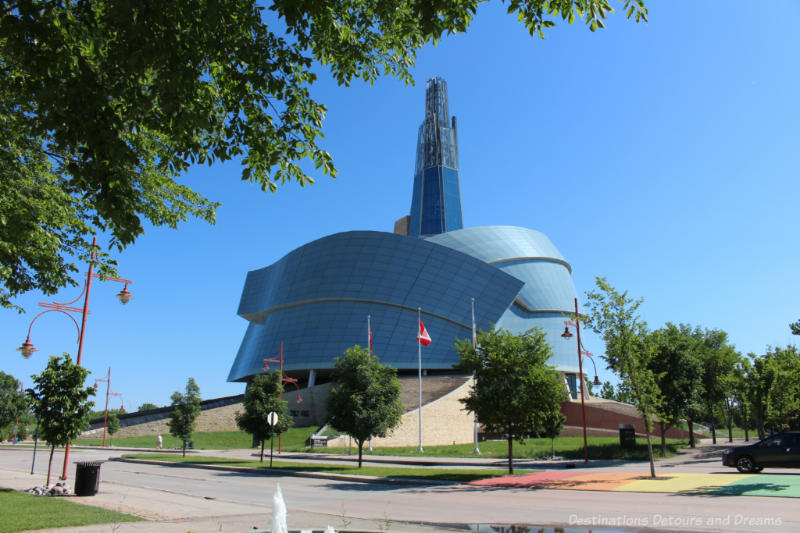
What to know about the Canadian Museum for Human Rights (CMHR) in Winnipeg, Manitoba, Canada
The Canadian Museum for Human Rights (CMHR) makes it to the top of lists of attractions and things to do in Winnipeg, Manitoba, Canada. Rightly so, in my opinion. Its eye-catching and symbolic architecture dominates the Winnipeg skyline. Innovative, multi-sensory exhibits tell human rights stories of struggle, courage, and resilience.
I’ve visited the museum several times. Each visit has been unique. With exhibits updated multiple times a year, I find a new exhibit or I delve differently into a story I’ve passed by before and see it from a new perspective. When I visit with friends or family, I am struck by how differently they may react. The message one person took away from the museum was how far we had come in the struggle for human rights. Another person was awed by how very, very recent the recognition of fundamental rights had been.
The exhibits are designed to encourage discussion and inspire action. Human rights stories from around the world focus on injustices, human rights triumphs, and people who have made a difference. They make us think about our own role in contemporary human rights. Although the topics covered can be heart-breaking, the overall message is one of hope.
I’ve written several other posts about the museum, each focused on different aspects of it. This post is designed to provide a more complete guide to the museum overall.
CMHR Creation
CMHR Architecture
CMHR Location
CMHR Navigation
CMHR Galleries and Exhibits
CMHR Exhibitions
CMHR Israel Asper Tower of Hope
CMHR Stuart Clark Garden of Contemplation
Visiting the CMHR
CMHR Creation
CMHR, devoted to human rights awareness and education, opened in September of 2014. It is one of nine national museums of Canada, designated under the federal Museums Act and operated by the Government of Canada.
The museum was 14 years in the making. It was the vision of businessman and philanthropist Israel Asper, who laid out the vision in a concept document in 2000. In 2002, Friends of the Canadian Museum for Human Rights was created to oversee the creation and spearhead fundraising. In addition to funding by the city, provincial, and federal governments, over 8,000 individual donors contributed over $147 million.
Israel Asper died in April 2003, six months after announcing the museum would be located at the fork of the Red and Assiniboine Rivers in downtown Winnipeg. His family continued to work on his dream.
The journey to build the museum was not without controversy. Funding and construction faced criticism at times, as did the choice of what exhibits were included and what were not. The sad fact is that the sheer volume of human rights abuses in our world’s history exceeds the capacity of a single building to contain all their stories.
In spite of the controversy, determination to create the museum remained strong. On September 19, 2014, a moving Opening Ceremony was held on the grounds outside the building and was televised live.
CMHR Architecture
In 2003, two weeks after the death of Israel Asper, a symbolic sod-turning ceremony was held and an architectural competition for design of the building announced. Entries were submitted from 64 countries. Antoine Predock of Santa Fe, New Mexico, won the competition. His design symbolized the idea of an upward struggle for human rights as a journey of hope.
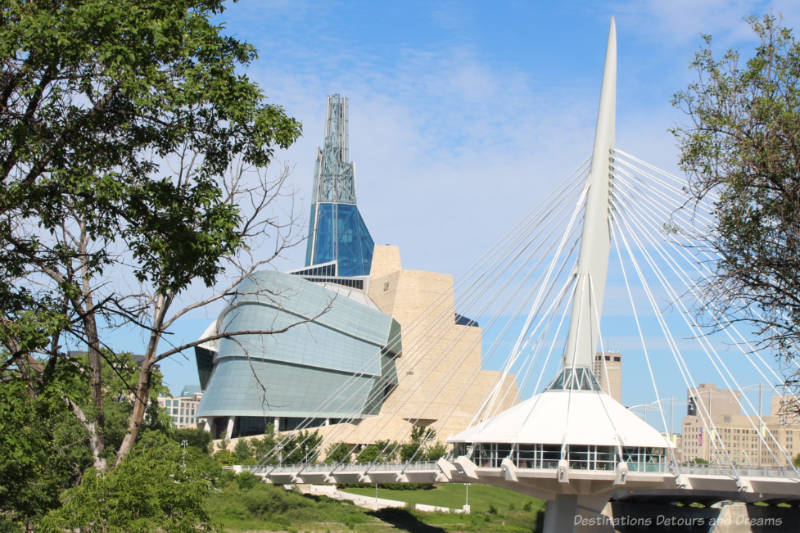
The museum has four foundations (roots) connecting it to the earth. Prairie grasses grow on three of these roots. Walls made of prairie Tyndall stone form the mountain rising from the earth.
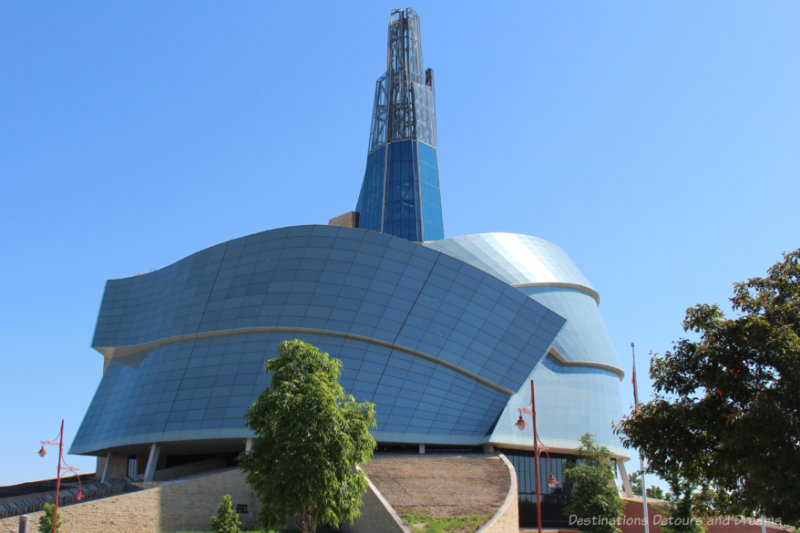
A “cloud” of sheets of glass fold around the northern façade like the wings of a dove. There are fifteen hundred light blue panels of glass, no two exactly the same shape.
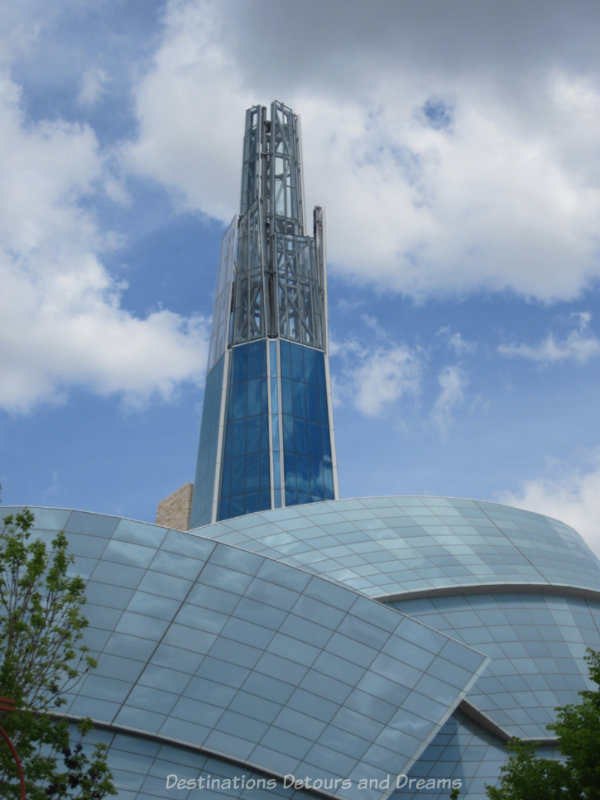
The Tower of Hope projects upward from the cloud. The glass spire rises 100 metres into the air with an observation deck at 85 meters. It is illuminated at night as a symbol of enlightenment.
On one of my visits, a greeter told me to look up at the odd angles. “There are no right angles in this museum,” she said. Architect Antoine Predock said you cannot box in human rights.
The design of the building contributes to the overall experience. There is a calm, atmosphere that fosters focus and reflection.
CMHR Location
The museum is located at The Forks, a meeting and recreational place in the heart of the city. The site at the junction of the Red and Assiniboine Rivers has been a traditional meeting place for thousands of years.
The museum funded an archaeological dig at the site that occurred in two stages between 2008 and 2012. The archaeological excavation was another controversial issue because some claimed it didn’t go far enough or wasn’t thorough enough. Still, 400,000 artifacts were found. They included 191 fire pits, more than 13,000 pottery shards, at least five previously unseen types of ceramics, more than 200 stone tools, more than 50 bone tools, and many sacred materials. The artifacts now reside with the Provincial Historic Resources Branch.
CMHR Navigation
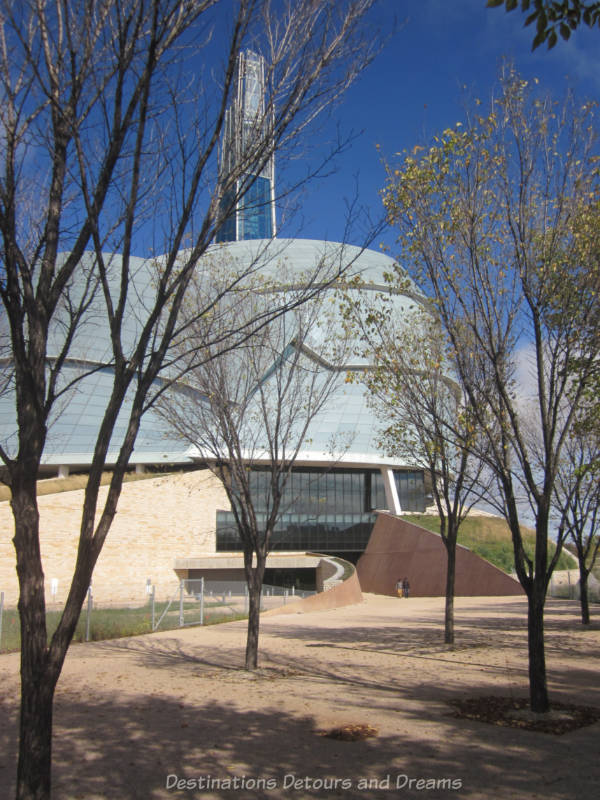
Your visit begins with walking down a slight decline to the entrance of the museum and into the Bonnie and John Buhler Hall, the museum’s large dimly-lit entrance room. The decline and dimness symbolize the start of the journey from the middle of the earth. During a tour I took when the museum first opened, our guide asked how we felt waiting in that room for the tour to begin. Many commented on a feeling of being closed in. I also sensed a quiet reverence and solemnness.
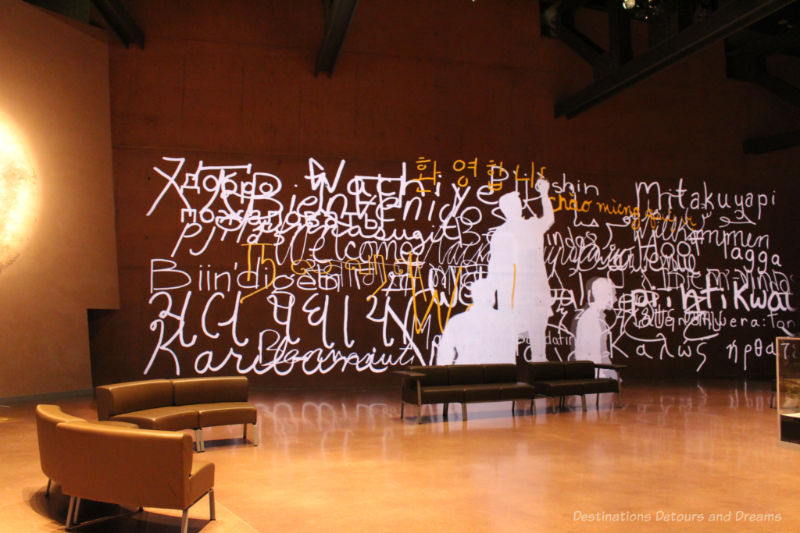
Outlines of people writing “Welcome” in many languages are projected across one wall of the hall. From here, a ramp winds up to the first galleries.
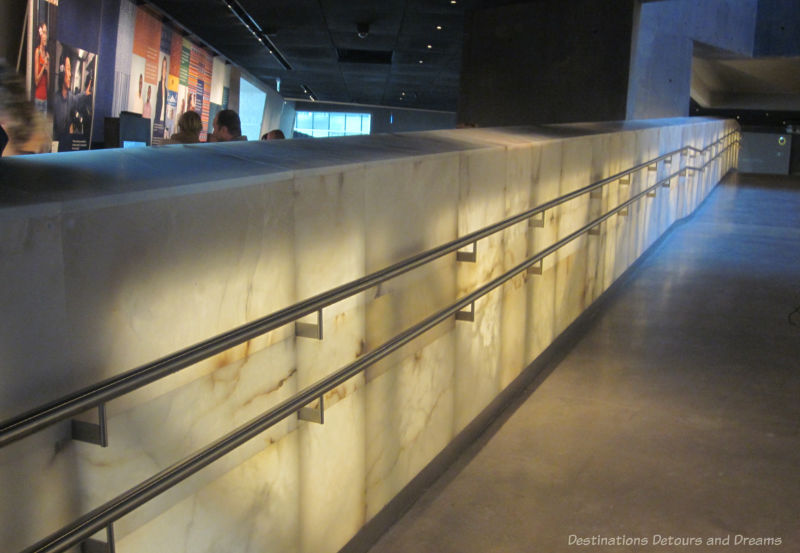
The theme of a journey of hope continues inside the museum with LED-lit inclined ramps creating a path of light through darkness. The ramps criss-cross upward between chalkboard black concrete walls guiding you through seven levels. In early history, essential oils and medicines were stored in alabaster jars. The choice of alabaster for the ramps symbolizes a process of healing.
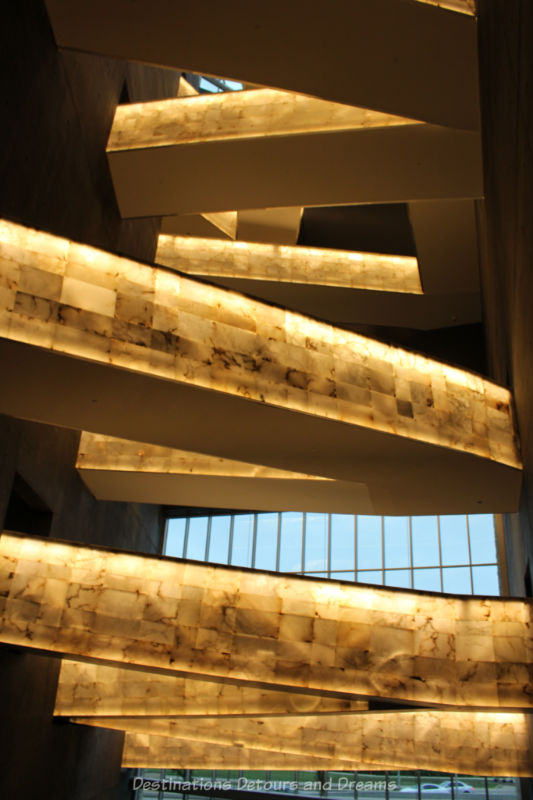
The ramps are not the only way to go from floor to floor. The museum is accessible and there are elevators. If you are able, I suggest you take the ramps for at least one floor to experience the feeling it conveys. The openness of the museum also means you get interesting views into galleries from the ramps. Be aware, however, that the ramps cover a lot of ground. Even with resting spots at regular intervals, you may wish to take the elevator for at least part of the time to conserve your walking energy for the galleries themselves. The galleries also have spots where you can sit. Whether you use the ramps or the elevators or a combination, I recommend wearing comfortable walking shoes.
CMHR Galleries and Exhibits
The galleries use multi-sensory exhibits, textual information on panels, films, projections of images and texts on walls, interactive video recordings, and visual displays to engage people.
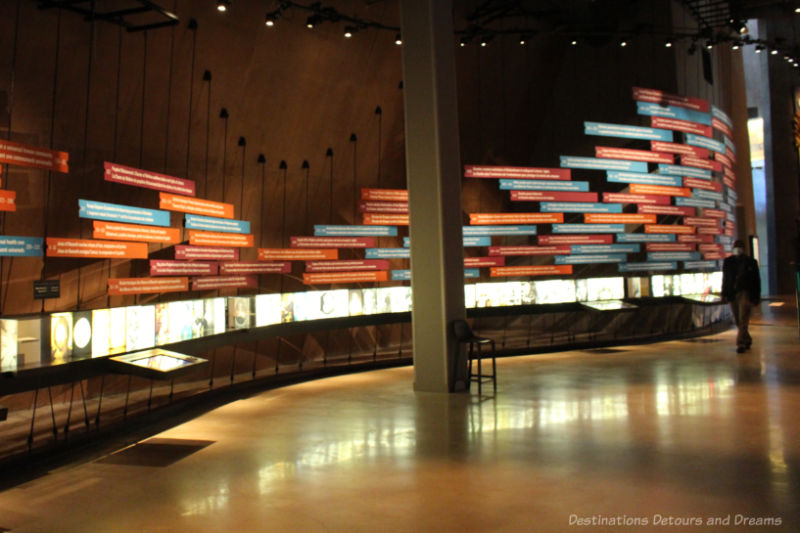
The first gallery, What are Human Rights?, is considered an introductory gallery. It contains a human rights timeline dating back 4,000 years and assorted other displays. Interactive screens allow you to delve more deeply into the timeline. The following quote appears on the wall as you enter the gallery.
Throughout history, people have grappled with ideas about human dignity, respect, and responsibility. Today the term “human rights” generally refers to the rights and freedoms we have simply because we are human. It is an idea thousands of years in the making.
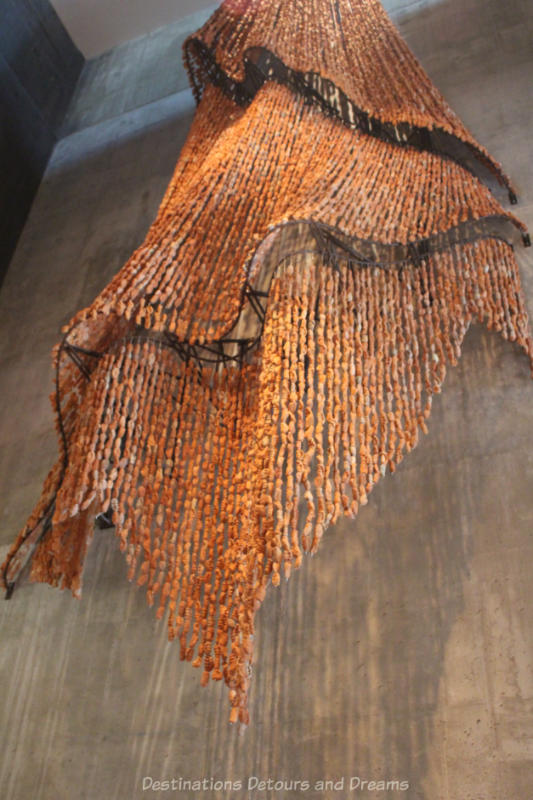
The Indigenous Perspectives gallery provides an introduction to the indigenous view of human rights through art, displays on the walls, and a short film in a 360-degree theatre.
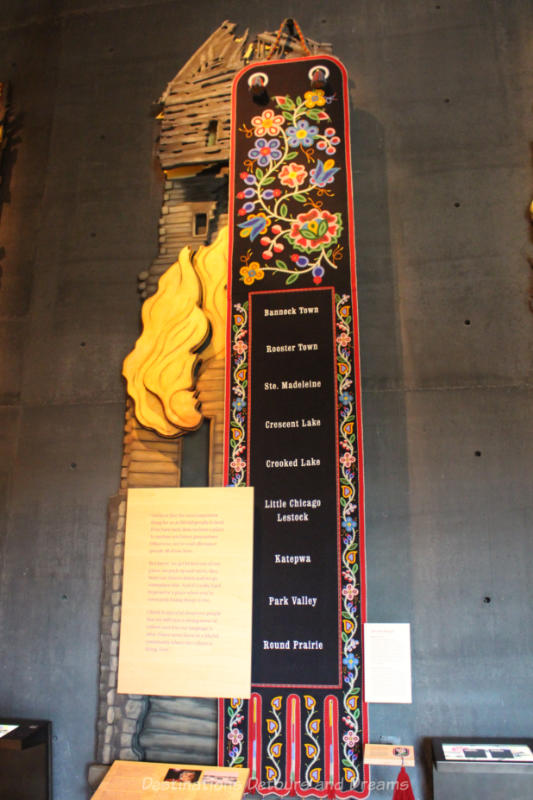
A seven-metre tall, 27 kilogram “octopus bag” is displayed as part of an exhibit about the displacement of Métis people who lived in communities on government road allowances. It is covered in a traditional Métis floral beadwork pattern using thousands of antique beads from the mid-1800s. It was created by artist Jennine Krauchi and her mother Jenny Meyer with assistance from the children of Brooklands school and members of the Manitoba Métis community.
It bears the names of road allowance communities. From the late 1800s up until the 1950s, many Métis people, dispossessed of the land they’d traditionally lived on by homesteading and the scrip process, lived in makeshift communities built on government-owned land in areas where temporary employment was available. They became known as road allowance people. The government would often force the communities off the land using extreme measures.
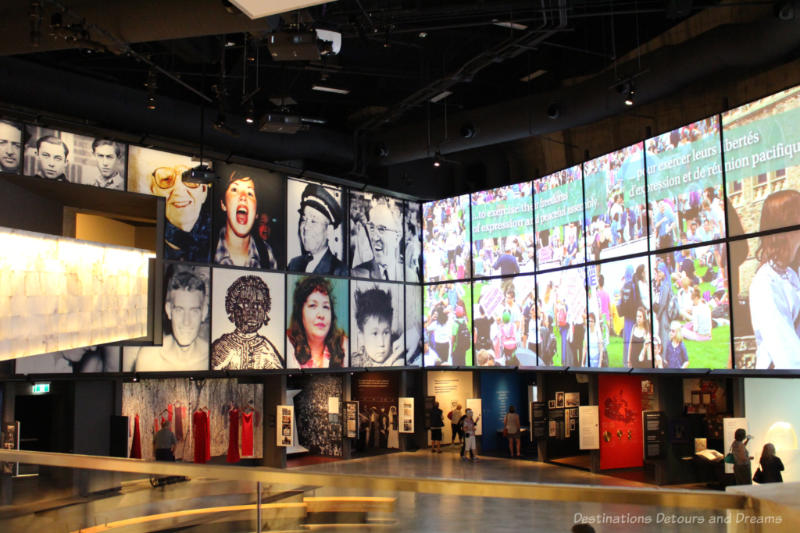
The Canadian Journeys gallery is a personal favourite. The gallery focuses on the steps and missteps along the road to greater rights for everyone in Canada. Projected images of people involved in that struggle appear along the top part of the walls of the high-ceilinged room. Displays along the perimeter underneath tell a variety of Canadian stories. These stories include the plight of Chinese immigrants who helped build the national railways, the underground railroad, the internment of the Japanese during World War II, language struggles, racial discrimination, the labour movement, women’s right to vote, the residential school system, and violent crimes against indigenous women.
Protecting Rights in Canada focuses on the evolution of the Canadian legal system to protect human rights.
Examining the Holocaust gallery looks at the history and horrors of the Holocaust. The stories here are difficult to handle. This is the darkest part of the museum, both literally and figuratively. Part of the exhibit includes Canada’s own disturbing experiences with anti-Semitism. The intent of the gallery is to examine the Holocaust to learn to recognize genocide and try to prevent it.
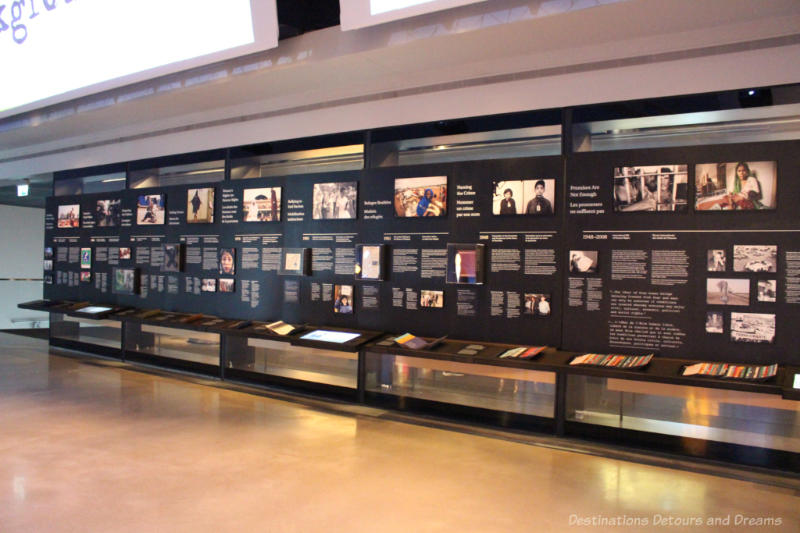
The Turning Points for Humanity gallery explores how people working together have gained new protections for human rights. In 1948, the United Nations General Assembly adopted the Universal Declaration of Human Rights which recognized the idea that rights belong to us just because we are human, no matter who we are or where we live. People continue to work to make this a reality. Many of their stories are featured in this gallery.
The Breaking the Silence gallery explores the role of secrecy and denial in atrocities around the world and the importance of speaking out.
The Actions Count gallery is inspired by Canadians making a difference in their communities and around the world.
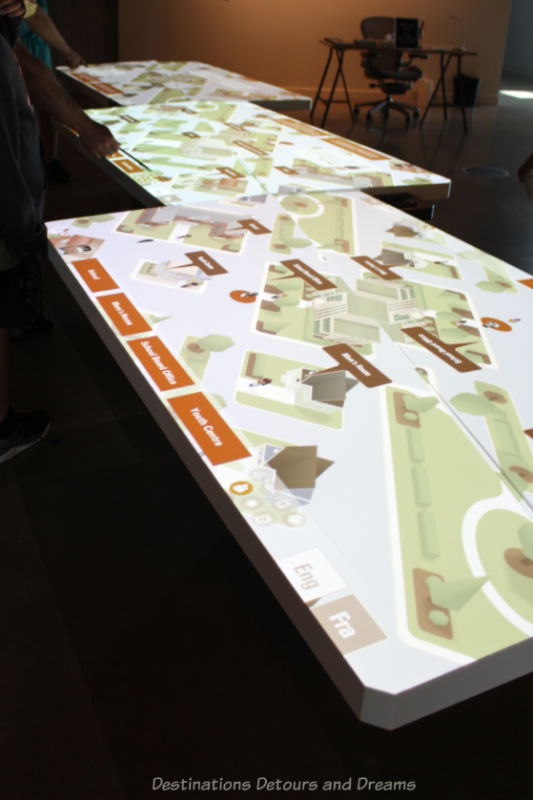
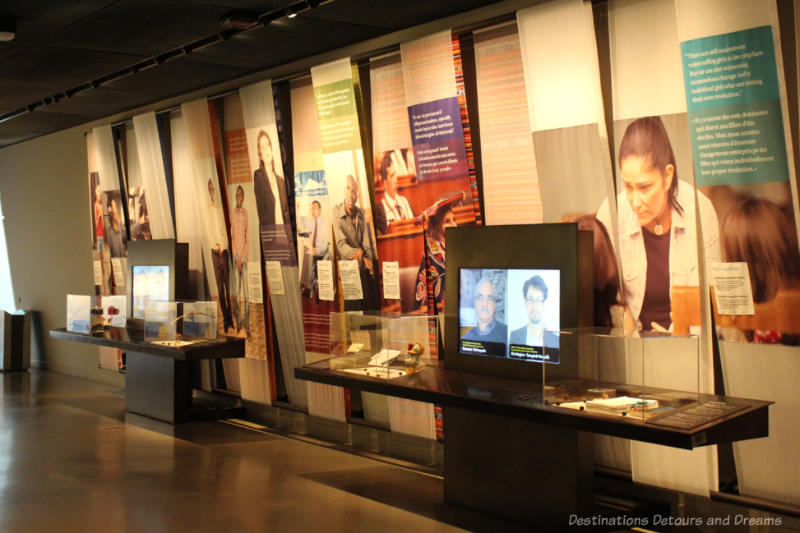
The Rights Today gallery focuses on contemporary human rights struggles and actions. It features an interactive wall map, a tapestry of human rights defenders, and a small theatre to make us think critically.
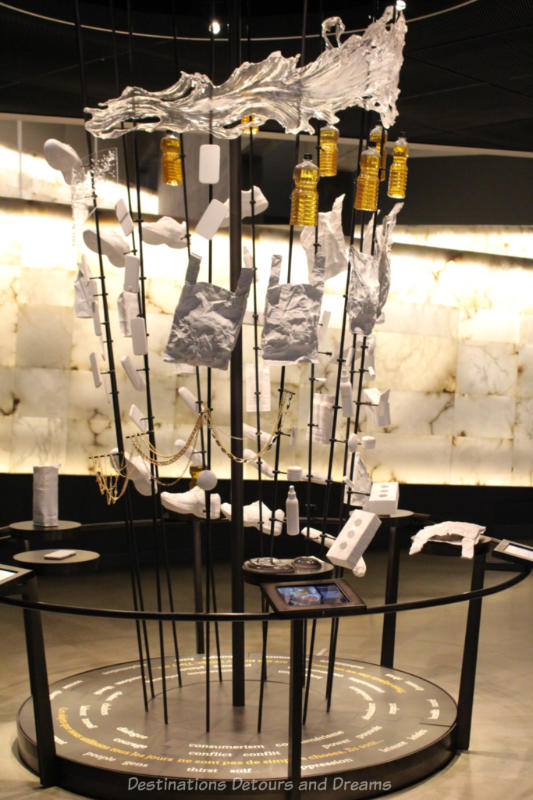
The above sculpture is an example of how this gallery encourages us to think critically about human rights. The everyday objects on display have both positive and negative impacts. For example, the cell phone has transformed how people get the word out to others and can draw worldwide attention to human rights issues as they unfold. On the other hand, cell phones contain coltan, a material often linked to child labour and other human rights issues in the Democratic Republic of Congo.
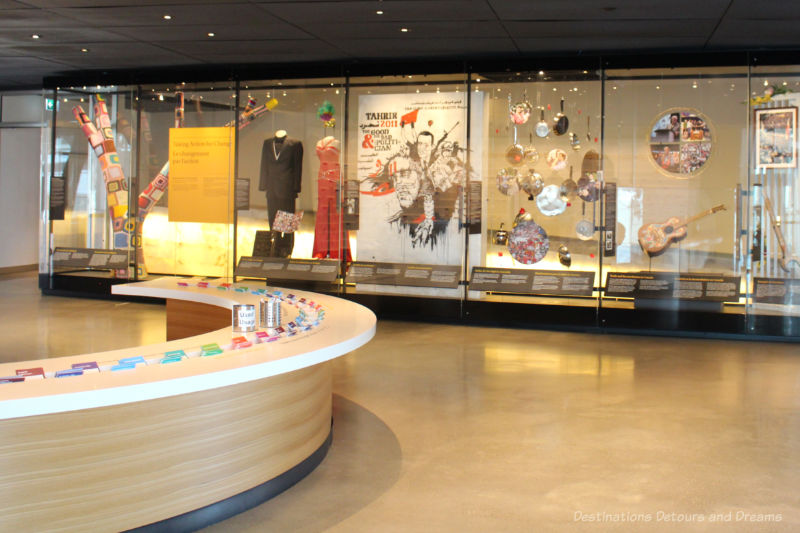
The Inspiring Change is the last gallery in the upward journey through the museum. This gallery focuses on what positive change for human rights looks like and encourages visitors to contemplate their own roles in human rights.
CMHR Exhibitions
In addition to its permanent displays, the museum features special exhibitions in its Level 6 Expressions gallery and on the main floor Gallery.
Special exhibits not large enough to fill a gallery on their own may sometimes be found within one of the museum’s regular galleries.
The Inspiring Change gallery hosts the permanent Truth and Reconciliation exhibition. Exhibits explore the tragic story and legacy of residential schools.
As early as the 1870s and as late as 1966, many First Nations, Métis, and Inuit children in Canada were forced into residential schools, often against parental wishes. Many were forbidden to speak their own language or practice their culture. In a number of schools, physical and sexual abuse also occurred. In 2008 the Truth and Reconciliation Commission was formed to learn and document the truth of what happened as a step toward reconciliation and healing. They examined records and collected testimonies from school officials and residential school survivors and their families and communities.
Special exhibitions are included in the price of admission.
CMHR Israel Asper Tower of Hope
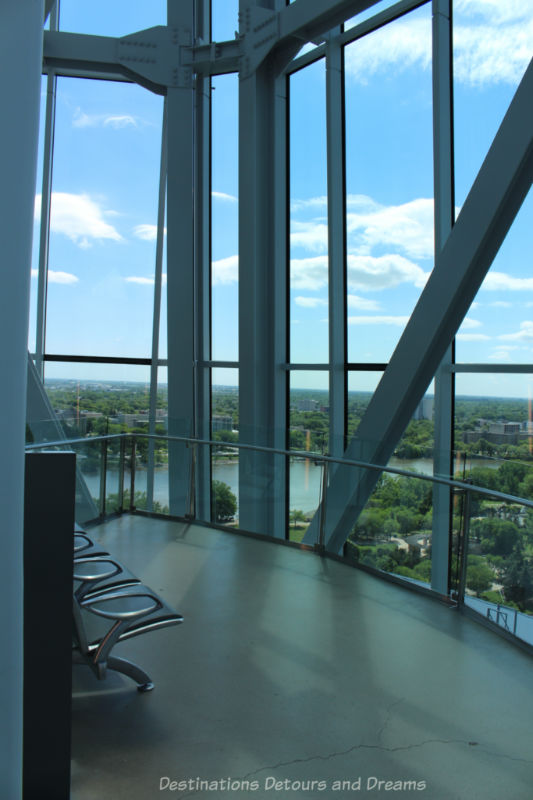
The Israel Asper Tower of Hope is a 23-story glass spire featuring a viewing platform that offers panoramic views of the city and the prairie beyond it.
CMHR Stuart Clark Garden of Contemplation
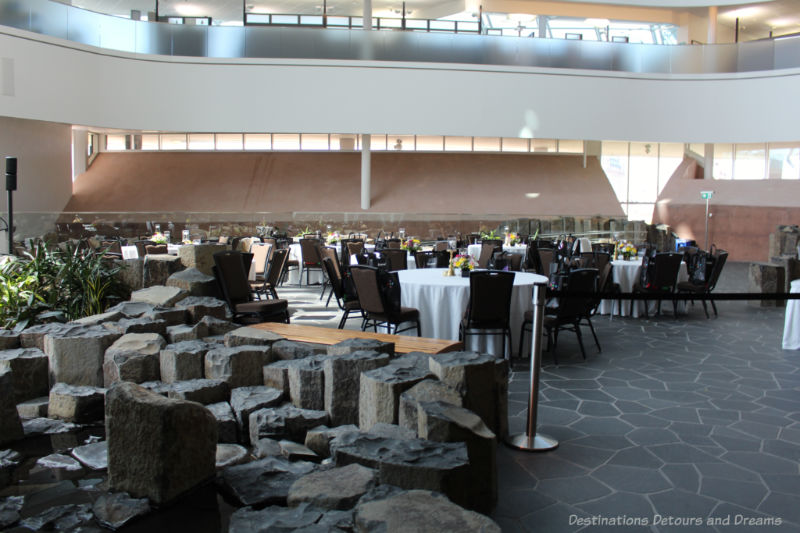
Located on Level 3, the Stuart Clark Garden of Contemplation features basalt rock columns, pools of water framed by hand-cut tiles, and plants. It is a calm and peaceful spot to spend some time reflecting. In the photo above, the space is set up for a lunch-time event.
Visiting the CMHR
See the museum website for hours of operation and admission price information. Non-flash photography is encouraged. Parking is available at metered lots around the museum.
You can explore the museum on your own or use the free mobile app to guide you through the museum. Use the museum’s free Wi-Fi to download to your iOS or Android device. Contact the museum for information on guided on-site tours. There are also some guided virtual tours available.
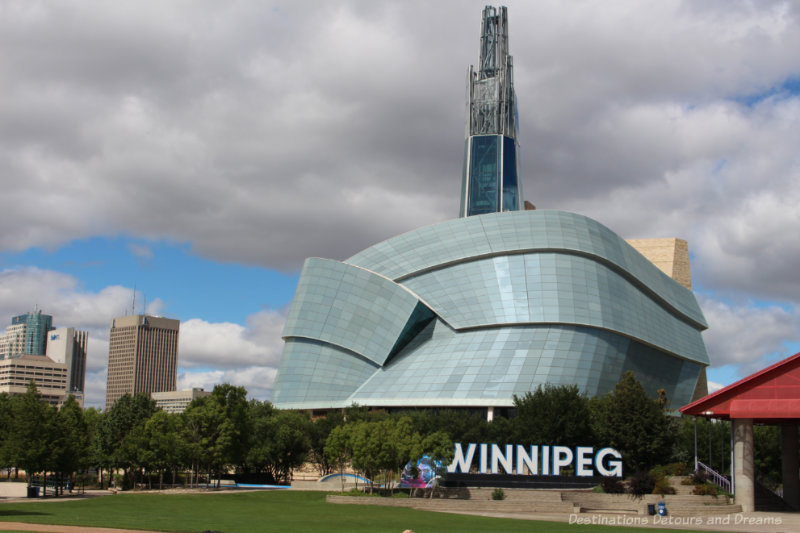
The museum encourages visitors of all ages. However, not every exhibit is suitable for children of all ages. The museum has prepared age-appropriate guides for families exploring the museum with children. See the Children and Families section of their website.
For adults visiting the museum, allow somewhere between two and three hours for your visit.
There is a coffee shop on Level 3. The Boutique on the main floor contains a beautiful selection of socially conscious giftware.
Never miss a story. Sign up for Destinations Detours and Dreams free monthly e-newsletter and receive behind-the-scenes information and sneak peaks ahead.
PIN IT

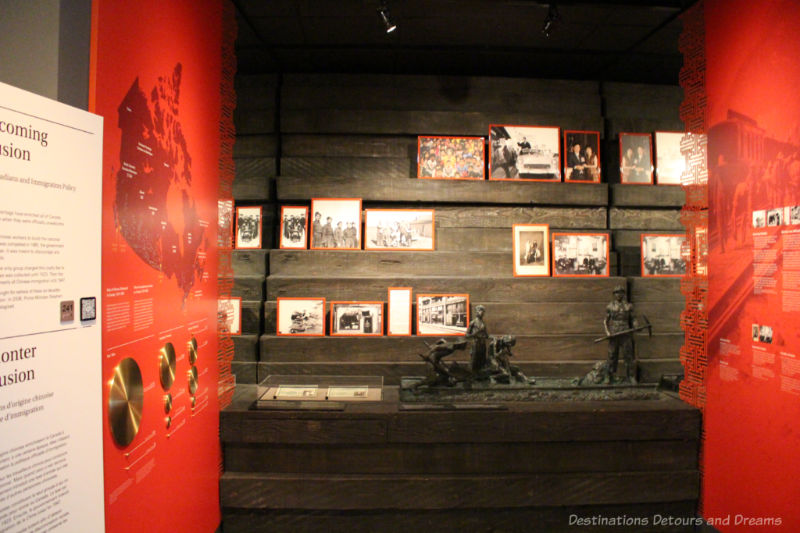
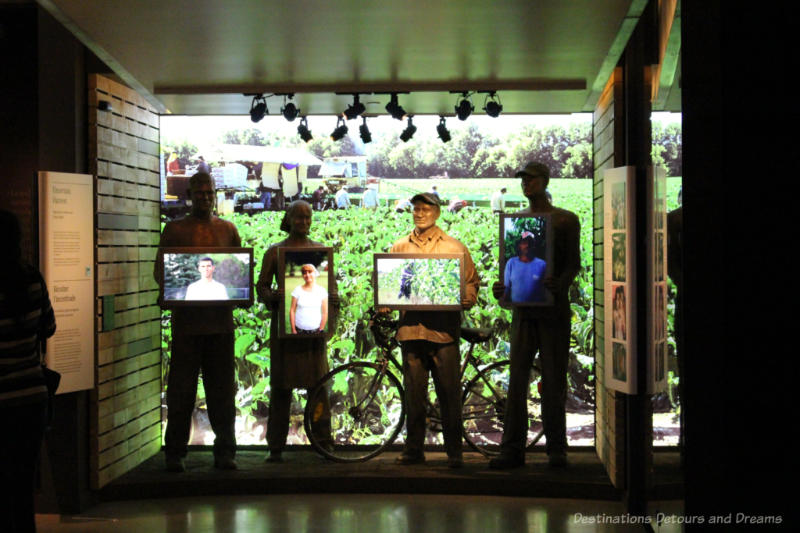
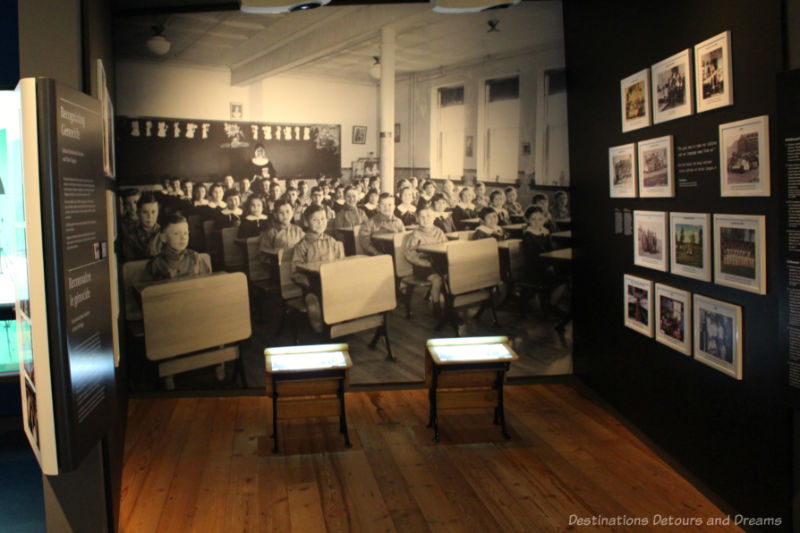
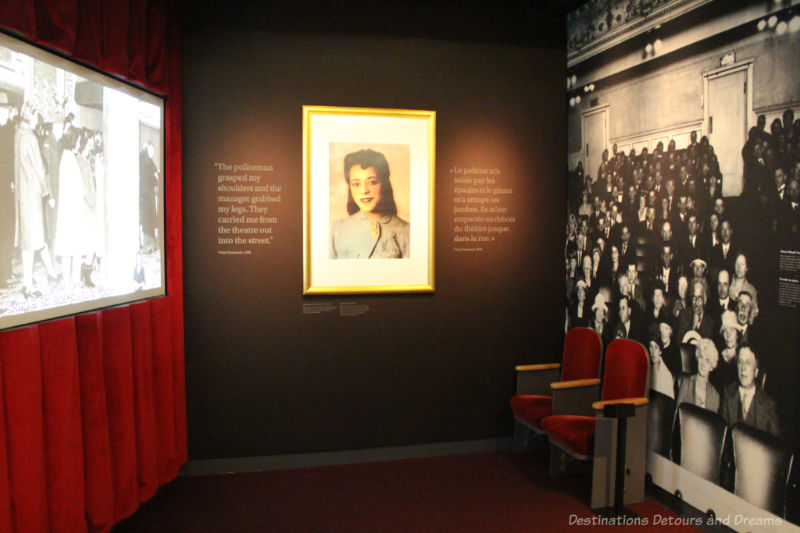
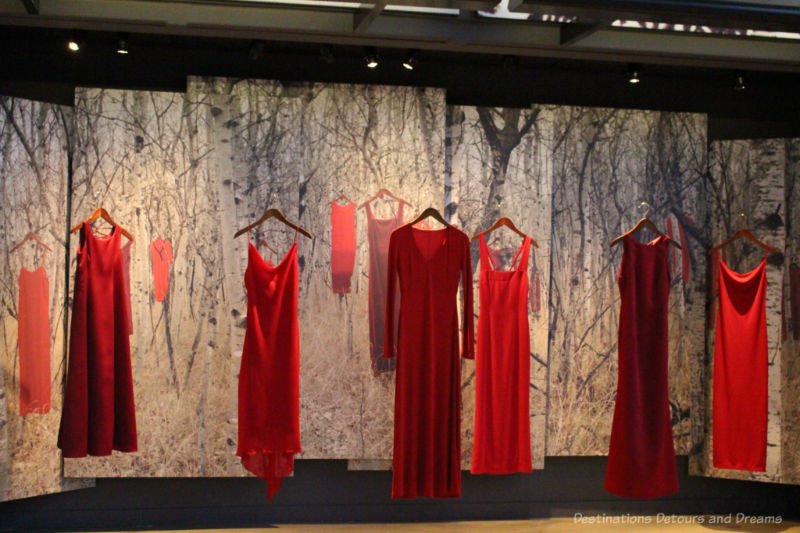
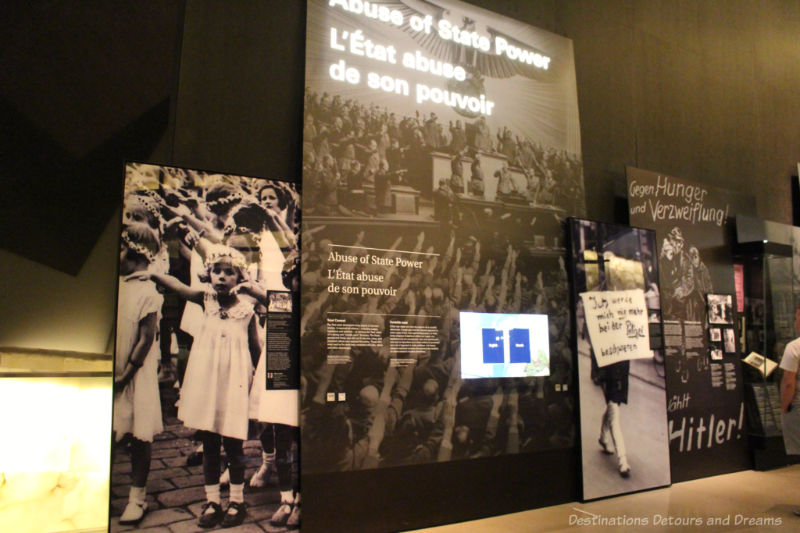
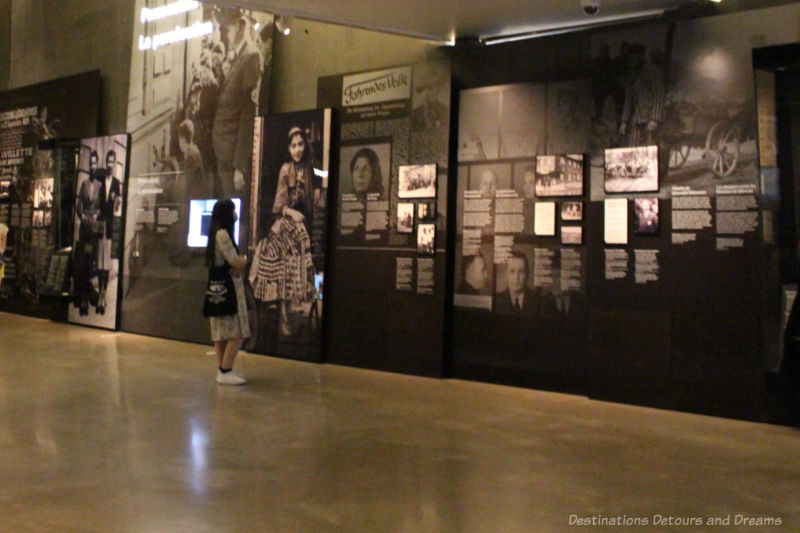
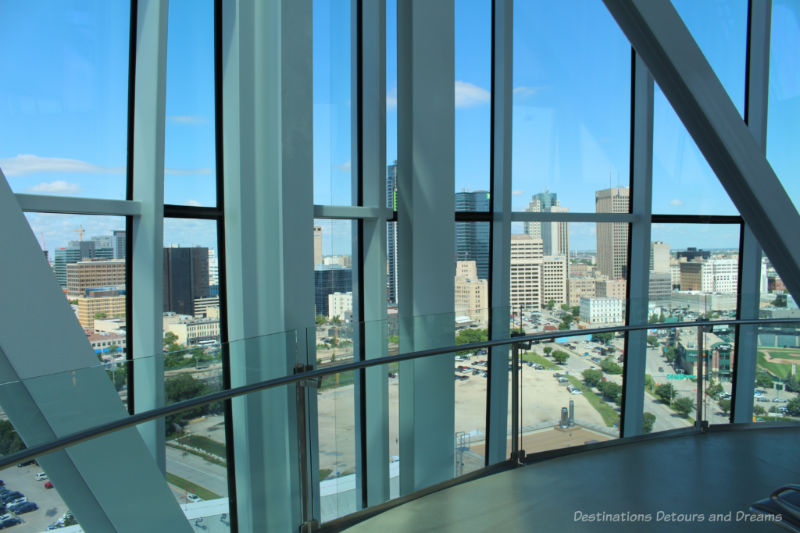
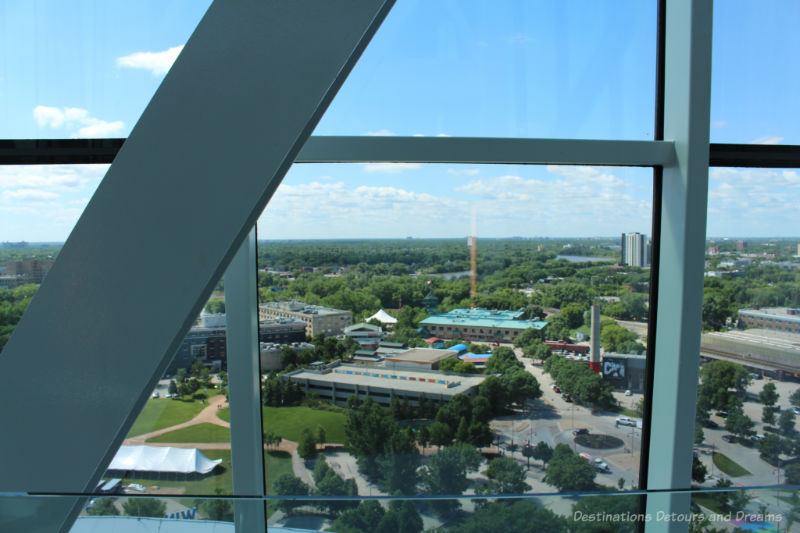
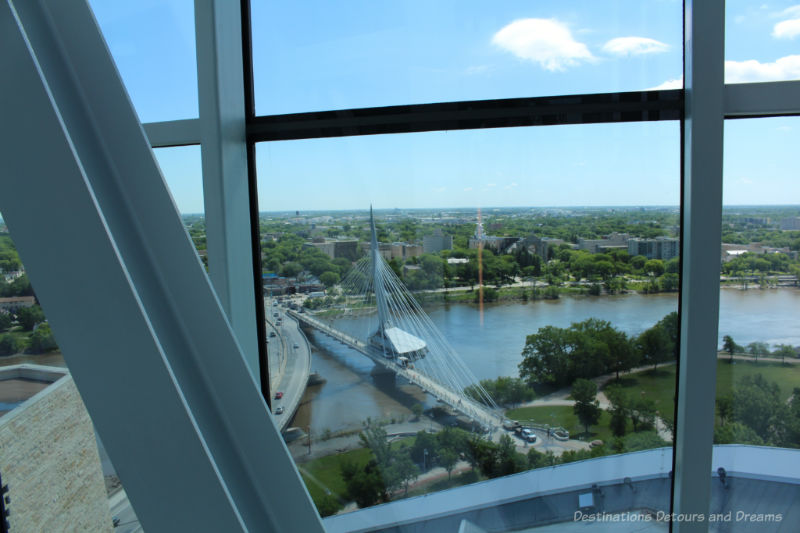
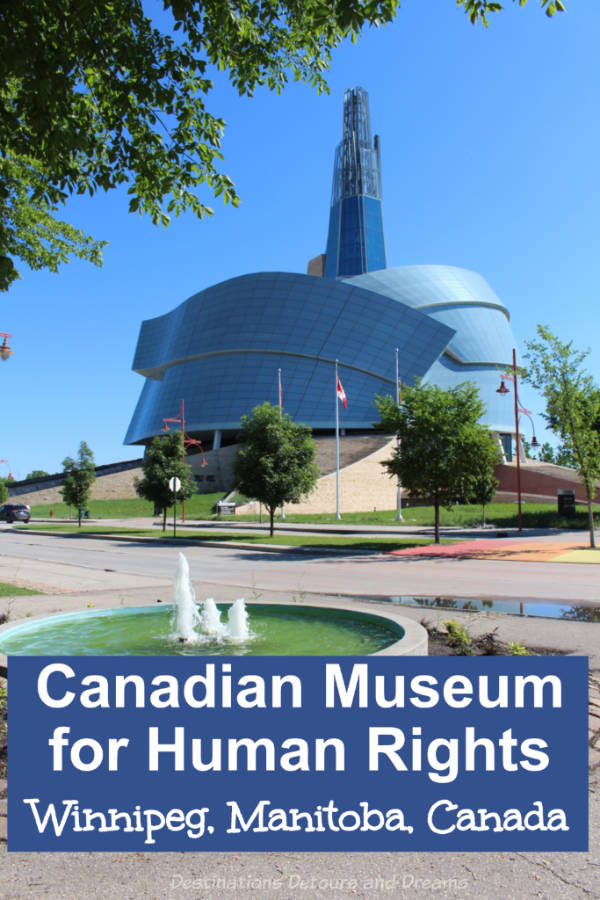
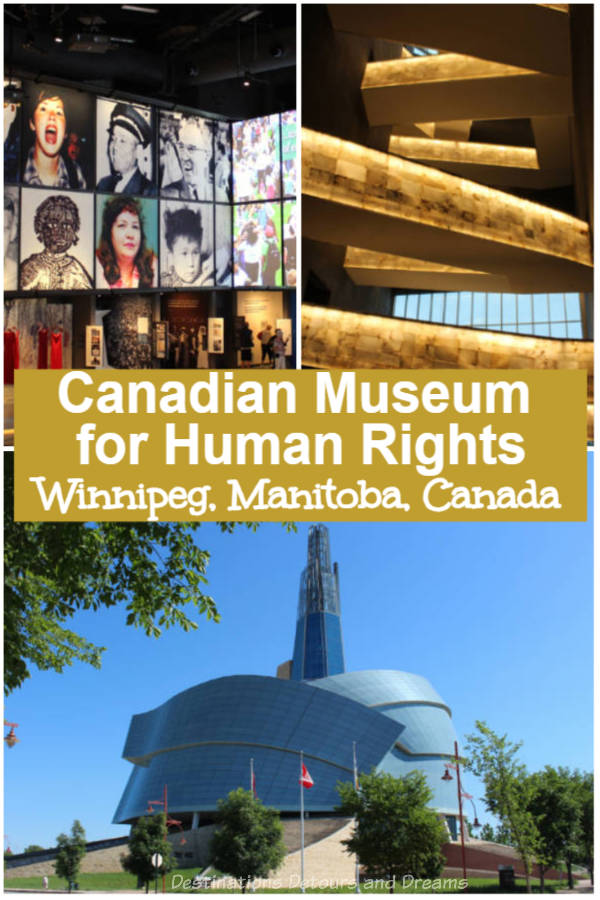
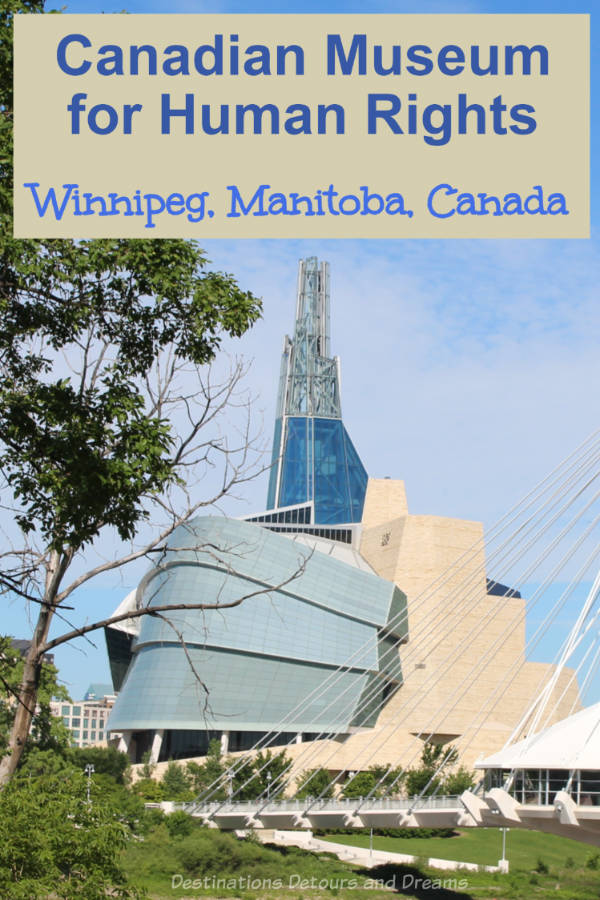
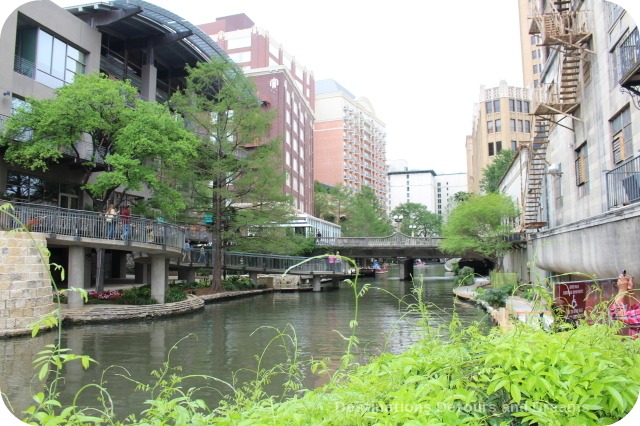
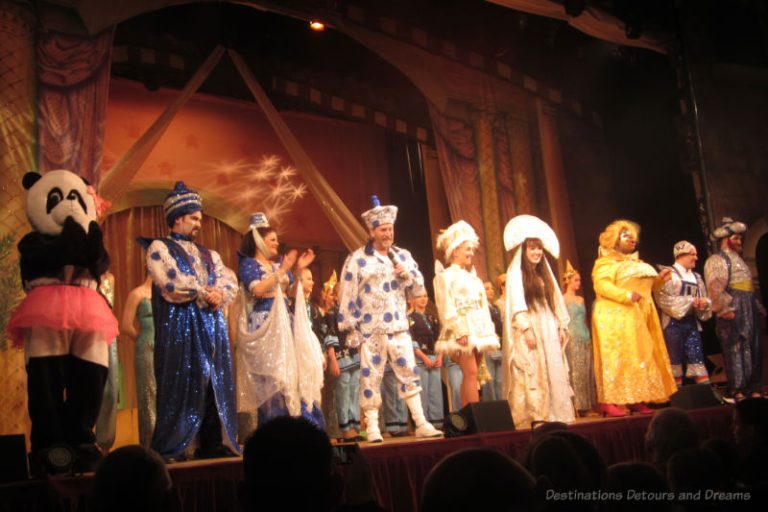
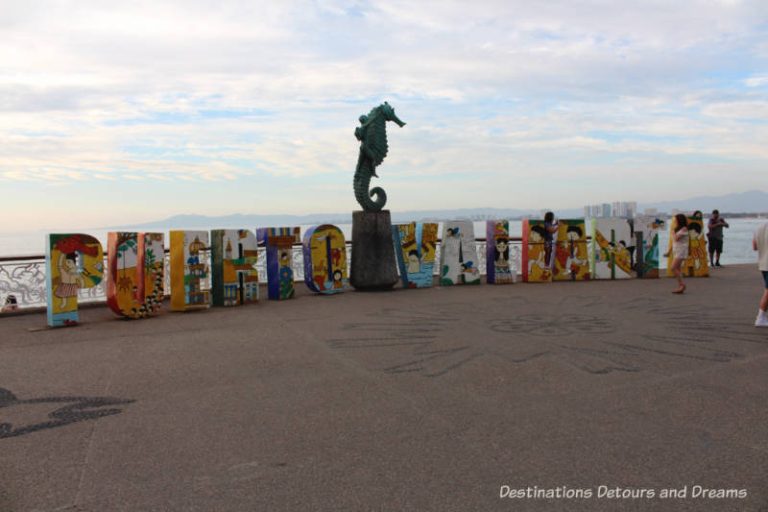
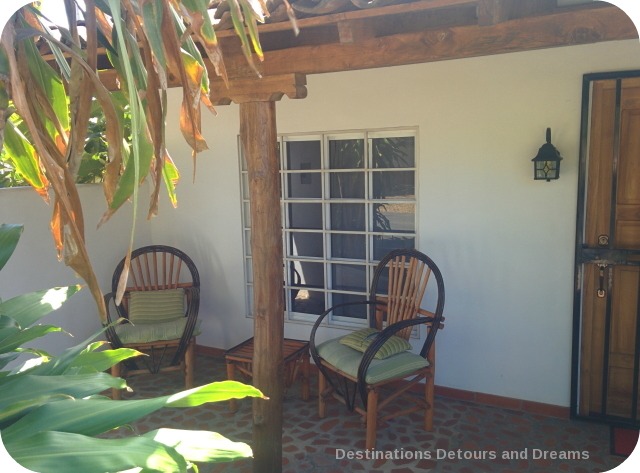
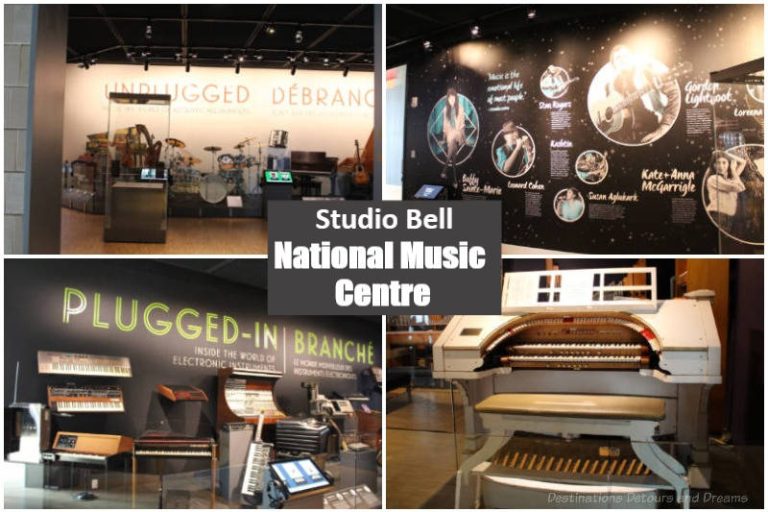
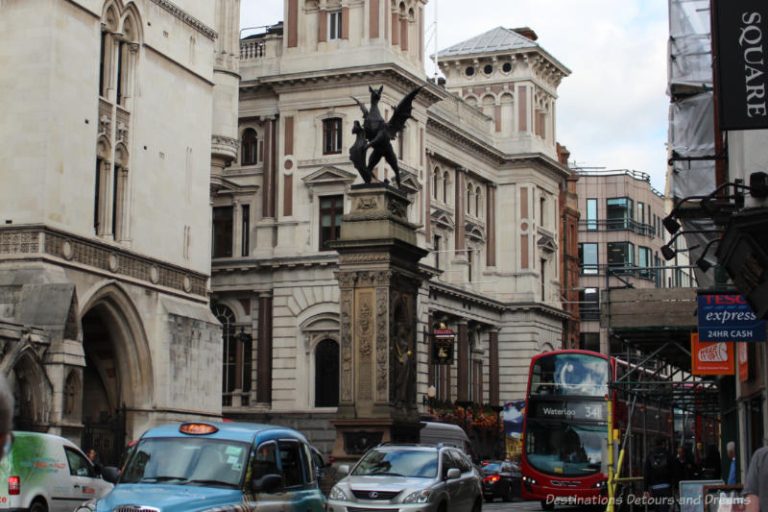
Great concept for a museum. Hope to get there someday.